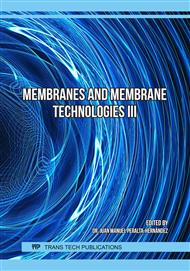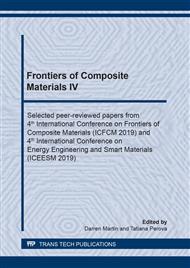p.155
p.161
p.168
p.174
p.183
p.189
p.197
p.203
p.209
Kinetics and Isotherms of an Iron-Modified Montmorillonite/Polycaprolactone Composite Nanofiber Membrane for the Adsorption of Cu(II) Ions
Abstract:
Exposure to toxic concentrations of Cu (II) continues to rise as developing countries undergo rapid industrialization. Because of its high solubility in water, improperly disposed copper contaminate our water sources in its aqueous Cu (II) form. A nanofiber membrane composed of iron-modified montmorillonite (Fe-MMt) dispersed in polycaprolactone (PCL) was electrospun for the adsorption of Cu (II) ions. Kinetics and isotherm models were used to study the adsorption behavior of the fabricated membrane. The adsorption capacity of this membrane was observed as a function of increasing contact time and initial Cu (II) ion concentration. Kinetic studies showed that Cu (II) adsorption follows a pseudo-second order kinetic model, while isotherm studies determined the adsorption to be monolayer as described by the Langmuir isotherm. Furthermore, it was observed that the adsorption capacity increases with increasing contact time, and with increasing initial metal ion concentration up to a maximum value of 6.44 mgg-1. Lastly, the Dubinin-Kaganer-Radushkevich isotherm was used to calculate for the sorption energy and determine the type of adsorption. A sorption energy of-5.83 kJmol-1 was obtained, thus the adsorption was classified to be physical.
Info:
Periodical:
Pages:
183-188
Citation:
Online since:
June 2020
Authors:
Keywords:
Price:
Сopyright:
© 2020 Trans Tech Publications Ltd. All Rights Reserved
Share:
Citation:



